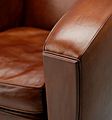Chatosis
The term chatose comes from the field of classic upholstery and describes a panel that is usually attached to the front of the arm parts of seating furniture - in some cases also to the side of the back part. Chatosen are mainly used to cover up the upholstery nails or brackets attached to the furniture. In this way, the overall picture of the furniture can be rounded off. Depending on the shape and material, chatoses can also be used specifically as a stylistic device.
material
In classic upholstery, chatoses are mainly made of wood. Either finely worked with ornaments, well sanded and stained as massive exposed wood panels, or as blind wood chatoses that are covered with fabric or leather. Wooden chatoses are usually attached with wooden dowels or nails. Today's modern upholstery industry has, in addition to the classic wooden chatose, various panels made of plastic or solid cardboard, which are fastened in various ways with plastic dowels, sleeve sleeves, nail strips, etc.
origin
The time of origin of the chatosis goes back a long way in history. Chatoses appear on furniture increasingly at the beginning of the 18th century, when in the bourgeoisie at the end of the Baroque era there was a transition from rather coarse furniture constructions, which were mostly only covered by loose cushions, to a degree of comfort, elegance and craftsmanship. During this time, the names of furniture manufacturers such as Chippendale or Sheraton became more and more style-defining for furniture.
The proportion of upholstered area in a piece of furniture grew. In the past, mostly only the seat and perhaps the back part were upholstered, but now the side parts were also lavishly covered. The seating furniture increasingly became fully upholstered furniture and so from a technical point of view, but also for stylistic reasons, wooden panels had to be used.
Fine, leather-covered chatoses form the perfect finish to the upholstery work on high-quality leather armchairs, such as this club armchair



